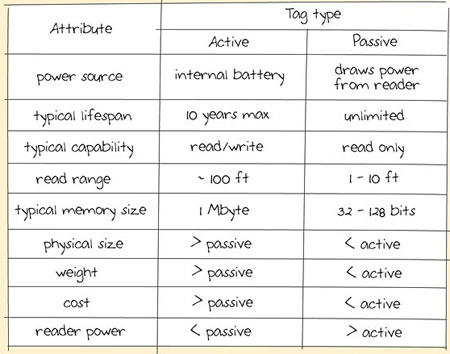7.5 Active and passive tags
Activity 30: exploratory
Read the extracts below. Using the information they contain, make notes about the main differences between active and passive RFID tags. You will get more out of this exercise if you make a serious attempt to do this before reading my answer.
RFID tags are categorised as either active or passive. Active RFID tags are powered by an internal battery and are typically read/write, i.e. tag data can be rewritten and/or modified. An active tag's memory size varies according to application requirements; some systems operate with up to 1 MB of memory. In a typical read/write RFID work-in-process system, a tag might give a machine a set of instructions, and the machine would then report its performance to the tag. This encoded data would then become part of the tagged part's history. The battery-supplied power of an active tag generally gives it a longer read range. The trade off is greater size, greater cost, and a limited operational life (which may yield a maximum of 10 years, depending upon operating temperatures and battery type).
Passive RFID tags operate without a separate external power source and obtain operating power generated from the reader. Passive tags are consequently much lighter than active tags, less expensive, and offer a virtually unlimited operational lifetime. The trade off is that they have shorter read ranges than active tags and require a higher-powered reader. Read-only tags are typically passive and are programmed with a unique set of data (usually 32 to 128 bits) that cannot be modified. Read-only tags most often operate as a license plate into a database, in the same way as linear barcodes reference a database containing modifiable product-specific information.
RFID systems are also distinguished by their frequency ranges. Low-frequency (30 kHz to 500 kHz) systems have short reading ranges and lower system costs. They are most commonly used in security access, asset tracking, and animal identification applications. High-frequency (850 MHz to 950 MHz and 2.4 GHz to 2.5 GHz) systems, offering long read ranges (greater than 90 feet) and high reading speeds, are used for such applications as railroad car tracking and automated toll collection. However, the higher performance of high-frequency RFID systems incurs higher system costs.
At the most basic level, there are two types of RFID tags, passive and active. Passive tags have no power and have to use the radio frequency (RF) field from the reader to transmit their signal from 1–10 feet, depending on the frequency. Active tags use their on-board power to transmit their signal hundreds of feet.
The simplest passive tags have their data burned permanently into the tag when it is made, and some passive tags can have their data rewritten many times. Active tags, on the other hand, can power random access memory (RAM), and typical tags store 32,000 bytes of data. Active tags can also power sensors that detect things like temperature or humidity.
An active tag is powered by an internal battery, which generally gives it a longer read range than passive tags, which obtain operating power from the reader. Active tags are also usually read/write in comparison with typically read-only passive tags. While active tags can operate with up to 1 MB of memory compared to the 32–128 bits of passive tags, the former are larger, heavier and more expensive than passive tags, which offer a virtually unlimited operating existence in contrast with a maximum active tag lifetime of 10 years. In addition to the lesser memory size, passive tags also have shorter reading ranges and require readers with higher power than those used with active tags. RFID systems are also distinguished by their frequency ranges. Low-frequency (30 kHz to 500 kHz) systems have short reading ranges and lower system costs. They are most commonly used in security access, asset tracking, and animal identification applications. High-frequency (850 MHz to 950 MHz and 2.4 GHz to 2.5 GHz) systems, offering long read ranges (greater than 90 feet) and high reading speeds, are used for such applications as railroad car tracking and automated toll collection. However, the higher performance of high-frequency RFID systems incurs higher system costs.
Discussion
My initial scan of the three extracts identified a number of clear differences between active and passive tags. So I decided to start by making notes in the form of a simple table, shown as Figure 21 below.
> means 'greater than'
~ means 'approximately'
Don't worry if you weren't able to identify quite as many differences as I did, but I hope you got the main ones about power source, lifespan, range and physical size.
The extracts also gave information about the characteristics of tags operating at different frequency ranges. I couldn't cross reference this directly to active or passive tags, so this would be something requiring further investigation.
I hope you also spotted that the information about frequency given in the first and third extracts was identical. This highlights an important point about web sources: very often they are plagiarised work themselves! In this case, one could be copied from the other, or they may have both taken the same section from yet another source. As an experiment, you could try entering a portion of the plagiarised section into a Google search – for example "higher performance of high-frequency RFID systems incurs higher system costs" – and see how many 'hits' are returned. (You must include the quotation marks because this forces Google to search for an exact phrase match.) When I tried, the search returned 64 sites!
It's easy to see how inaccurate information could proliferate on the Web in this way. The moral of the story here is, just because you see the same information repeated on various websites you cannot automatically assume it is accurate. You need to judge this against the authority of the sources. However, in this particular case, the source of the extract is AIM (Automatic Identification Manufacturers), the trade association for the Automatic Identification and Data Capture Industry, so it is safe to assume that the information they publish is reliable.
Activity 31: self-assessment
Use your notes from Activity 30 to write, in your own words, a short summary of the differences between active and passive RFID tags. You'll probably be able to do this using no more than 150 words. (Don't worry if your word count isn't close to this – at this stage, using your own words is more important than keeping close to the suggested length.) When you have finished, check back to the original source documents and make sure that your text is sufficiently different for it to be truly your own words.
Again, you'll get more out of this exercise if you make a serious attempt to produce your own answer before reading mine.
Answer
Here is my attempt:
There are two main types of RFID tag – active tags, which carry their own battery power source, and passive tags, which draw their power from the RFID reader. Active tags tend to be larger, heavier and more expensive than passive tags, but they also tend to have a larger memory size (typically 1 Mbyte) and a longer read range (about 100 feet). The lifespan of an active tag is limited to 10 years, but passive tags can have an unlimited lifespan. However, the performance capability of passive tags is lower as they have a shorter read range (no more than 10 feet), lower memory size (typically 32 to 128 bits), and typically read-only functions. Passive tags also require higher-powered readers.
The next section stays with the theme of RFID tags but gives you an opportunity to do a little research for yourself.

